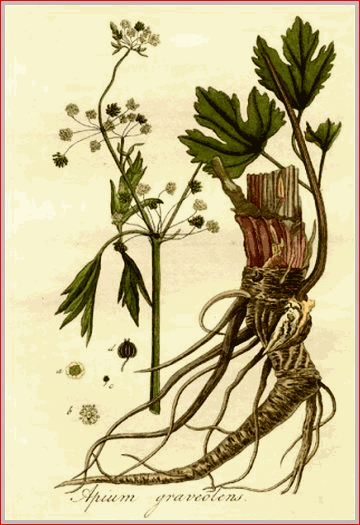
APII FRUCTUS. N. F. CELERY FRUIT Apii. Fruct [Celery Seed] APII
FRUCTUS. N. F. CELERY FRUIT (SEED)
APII
FRUCTUS. N. F. CELERY FRUIT (SEED)
United States Dispensatory 1926
Martindale�s 24th
Compiled by Ivor Hughes
Smallage; Marsh Parsley; Ache, Celeri, Fr.; Eppich, Cellsrie, G.; Apio, Sp.
Description and Physical Properties.
" Unground Celery Fruit. � Mericarps united or separate, ovoid, slightly curved, 1 to 2 mm. long and about half as broad and half as thick; dark brown; inner surface flat; outer surface convex, smooth except for 5 very slender light-colored ribs, 2 of which are marginal. Odor characteristic, agreeable; taste aromatic, warm and somewhat pungent.
" Structure. � Mericarp nearly equilaterally pentagonal in transverse section; with 6 to 165 oil-tubes in the pericarp, the latter closely surrounding a somewhat pentagonal seed; epidermis of pericarp with tangentially elongated cells, the latter with a thick cuticle and occasionally developed into short, smooth papillae; a fibro-vascular bundle in each of the ribs, composed of a few tracheae and strongly lignified fibers; inner tissue of pericarp of tangentially elongated parenchyma with brownish walls; seed chiefly of endosperm parenchyma; seed-coat of several layers of yellowish more or less collapsed cells; endosperm of thick-walled polygonal cells containing fixed oil and aleurone grains, the latter each with a small rosette of calcium oxalate.
"Powdered Celery Fruit. � Brown and oily; fragments of the pericarp with yellowish oil-tubes, brown secretion cells and few epidermal papillaB; tracheae and fibers; parenchyma cells of endosperm with aleurone grains, the latter usually containing rosettes of calcium oxalate, 0.002 to 0.008 mm. in diameter." N. F.
The celery plant is a hardy biennial native to Great Britain but cultivated in all parts of the temperate zone. In the wild state it has a rank disagreeable taste but by cultivation the leaves have lost their coarse taste and afford the familiar vegetable. The plant has a glabrous stem 1 to 3 feet high; the leaves are pinnate, the basal and lower being long-petioled and the upper short-stemmed. The small flowers are borne in umbels opposite the leaves.
Celery seed yields a volatile oil possessing the characteristic odor of the drug. This volatile oil consists chiefly of terpenes, but its odor appears to be due to two anhydrides: sedanolid C12H1802, the lactone of sedanolic acid, and sedanonic anhydride C12H18O3.
Apium nodiflorum (L.) B. et H. (Sium nodiflorum L.) Water parsnip. � This is a perennial, umbelliferous, aquatic, European plant, growing also in the southern section of the United States. It is commonly considered poisonous; but the fresh juice has been used by Withering and others, in the dose of three to four ounces every morning, for scrofulous lymphadenitis and obstinate skin diseases.
Uses. � There is a popular superstition among the uneducated that celery seed has a sedative and tonic effect upon the central nervous system and it is sometimes added to mixtures intended for nerve tonics. There is, however, not the slightest reason to ascribe any therapeutic virtue to the drug.
Dose
, from twenty to sixty grains (1.3 - 4 Gm.).Off. Prep.�Fluidextraetum Apii Fructus, N. F.; Elixir Guaranze et
Apii, N. F.
Martindale�s Extra Pharmacopoeia 24th Edition
.Celery (B.P.C. 1949, Ind. P.C.). Apium; Celery Fruit; Celery Seed. The dried ripe fruits of cultivated plants of celery, Apium graveolens (Umbelliferae), containing not less than 1.5% v/w of volatile oil. It has been reputed to have a sedative effect on the nervous system but it is of doubtful therapeutic value. A decoction (1 in 5; dose: 8 to 30 ml.) has been used as a domestic remedy for rheumatism. The oil from the fruits has been used as an antispasmodic and nerve stimulant in doses of 0-03 to 0-2 ml. and in rheumatoid arthritis in doses of 0-3 to 1 ml.
Fr, P. specifies the root (Ache des marais), which is used as a diuretic.
The US NF preparations may be found by using the site search box at the top right hand of the page.
![]()